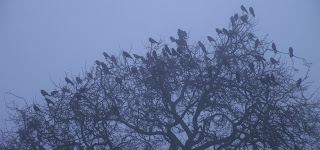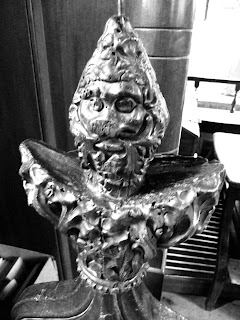Part One: Winter & Spring walking - Livermere,West Stow & the Fornhams.
Three & a half miles from home - towards West Stow.
Leaving Bury St Edmunds north-west, and slowly the traffic calms once off the A1101 and onto the slighty more sedate B1106. This corner of Tollgate Bridge has a marked sign for a friary on the OS map, yet all we can see is a Best Western hotel. Anyhow, over the river Lark and up into the village of Fornham St Martin. Having visited before in January, I march onwards to the junction of Fornham St Genevieve & the crossroads where the trees hold a colony of Rooks. When I last came here the Fornham villages were soaked in a heavy mist and, the caws of the plentiful Corvus Frugilegus gave this road junction a sinister air, less so today - the sun is gleaming through the cracked clouds.
The Fornham Rooks, in the January mists.
I forge my walk ahead, towards a fork in the road towards Culford & West Stow. There remains enough traffic to make me leap into a ditch every few minutes so, this deters me going directly to Culford, instead I branch left along the more sedate woodland road to West Stow. I am alone on a track amongst the trees of Dixons covert. I pass one oriental gentleman wobbling on a bicycle with his shopping bags wavering precariously; on each handle-bar. He takes me by surprise with his silent approach & catches me trying-out folk songs sang falsetto; I mutter an embarrassed hello.
Dixons covert - West Stow.
The woodland is all-engulfing. An occasioned ruffle of life amidst the forest floor leaves - a rabbit. I see no Dear here today, but grouse are in good numbers. Soon I am on the approach to West Stow, as the map promises. Revealed within the woodland is the church of St Mary. The name Stow defines an ancient holy place to the Anglo-Saxons and arriving here today feels much like it would have in the medieaval; I could be here 6 centuries ago & this building & it's setting would be pretty much the same. Sadly the church is locked and clouds threaten rain. I have a drink from the rucksack & plot my route forward.
The church of St Mary, West Stow.
A footpath leads me directly through the parkland of Culford. Now a school occupies the grotesque victorian monster, it's one redeeming feature being a lovely thatched cricket pavillion; the grass today being tweaked to perfection by four groundsmen. I find the church (within the school grounds), it is also a Victorian hideosity, the confines of the churchyard are lined with plants and raked gravel paths, anchoring an aesthetic of municipal seaside gardens. I have no time for it and scurry my way through the confusing school paths/sign-boards. Onto the main road, I traverse eastwards across the massive open fields of Place Farm. The route is a dusty, flint-strewn walk as winds shudder this great open expanse. The footpath exits through the farmyard buildings; I am always apprehensive about meeting a grisly farmer or worse - their dog! But, I am smiled at and talked too by the chaps in their John Deer overalls. We are now in Ingham; a name both Saxon & Viking. It is but a small cluster on the A134. I do find the public house: The Cadogan Arms. As I arrive it appears more restaurant, that I struggle to find the door which suggests bar. There isn't one. I push through and greeted immediately with false enthusiasms. The pub is horrifically new, devoid of any atmosphere. I ask for a ruby or dark beer. "Sorry, we have none"; this is a pub directly owned by a Bury St Edmunds micro-brewery! "We have Peroni, or Becks" suggests the bar-maid. "I will have an Aspalls Cider, Thank you". "Thats £4.20". I have to pay the cider-rape fee and sit in this horror of a pub, whilst business lunchers gawpe at the specials board above my head. I pop into the disabled toilet & on finishing mictruition, cannot help myself but write my disdain for the place & it's prices, on the a paper sanitory-towel disposal bag; I leave my declaration on the toilet mirror and exit with my own 'fake' goodbye. Through the gates of Ampton Hall Park.
Ampton, St Peter & St Paul.
Ampton church (1589) - the graffiti of the 16th century.
Little Livermere & Ampton Water.
Across the parkland we emerge on the brink of Ampton Water with the ruinous church of Little Livermere, it's tower proud amongst the farm buildings. The church of Ss Peter & Paul is said to have once been an excellent example of the Strwberry Gothick. As much as the scene is transfixing I am steered eastwards to Great Livermere, the tower of St Peter peering out of the scrub.
Great Livermere, St Peter.
It was at Great Livermere that Monty Rhodes James grew-up as the son of the parish rector. M. R James became a reverred Cambridge academic (Medievalist & Provost of Kings College) and one of our most esteemed writers of English ghost stories; many of which are grounded in the Suffolk landscape. The setting here is seemingly timeless; like centuries have passed unchanging. The church is locked (many are in N/W Suffolk), yet the sun eventually came to linger briefly and I chat for some minutes to a council gardener who, has come to strim the churchyard of its tall grasses.
Great Livermere.
I leave the churchyard and progress to the village green. A bus-stop, in the midst of nowhere and it promises a bus directly back to Bury St Edmunds in twenty minutes time; a service that swings-by only several times per day. I decide that I have walked enough, and rather than walk the miles home via Timworth, I decide upon this (chanced) lazier option. Firstly I go into the disused telephone box and insepect the donated books, in what is now a rural 'book exchange'. This is evidently a depository for un-wanted books (you know the kind), biographies of 20-something unknowns, Dick Francis, Mills & Boon and other un-wanted romantic fictions. This idea in principle is rather nice, but seems to have become a tidy litter-bin for damp paper; I suppose it is better than what most British telephone boxes once were - urinals. The bus comes along and, I am the sole passenger all the way back to Bury St Edmunds.., the driver seemed surprised that anybody at all put their hand out to stop and use this bus and, I feel extravagent in this over-sized chauffer-driven vehicle.
Home: Bury St Edmunds:
The processional gateway into the Abbey (The Norman Tower).































































